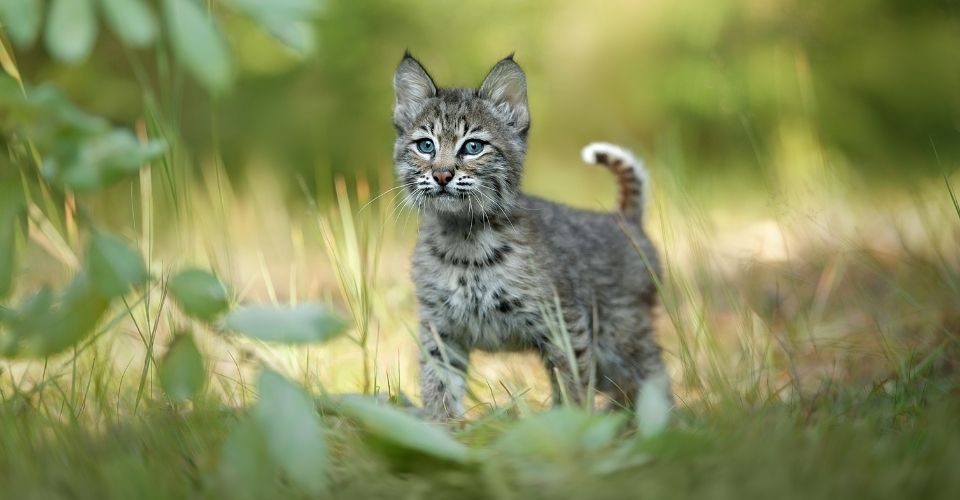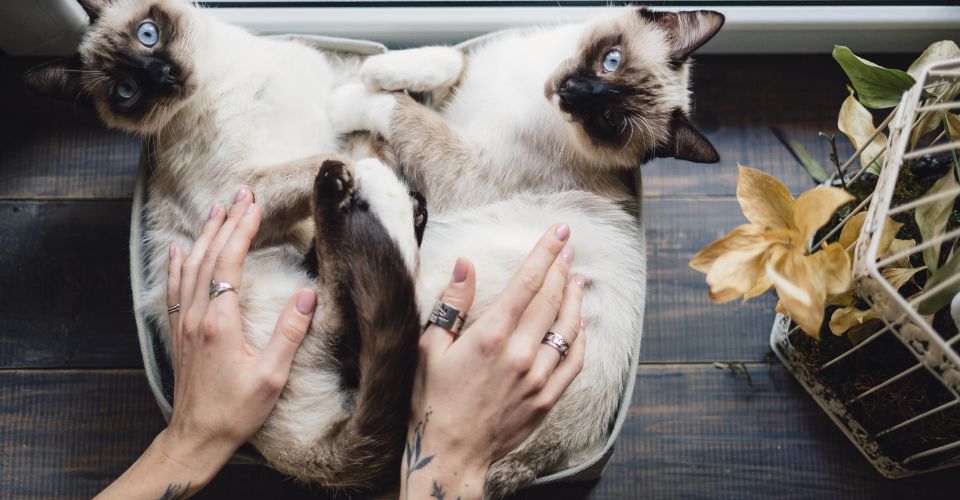The world of pets is changing. While keeping domestic cat breeds is a popular choice for many pet parents, many want to experience the exotic side of pets. For the same reason, you may see someone spending millions on keeping wild animals, such as tigers and lions. We at Keeping Pet discourage keeping large wild animals as pets. But what about exotic house cats? Or, what about those cats that are domestic but have wild-like looks?
For that, we have a simple formula. If the state laws allow it, it is fine. Else, it is better not to keep them as pets as keeping one would have repercussions, ranging from personal harm to environmental.
In this article, we share a list of some of the exotic house cats and whether you can keep them or not.
1. Ocicat

Breed Overview
Size (inches): 9 to 11 inches
Weight (pounds): 6 to 15 pounds
Hypoallergenic: No
Coat Colors: Chocolate / brown / sable cinnamon lavender / silver fawn lilac
Personality: Sociable, affectionate
Lifespan: 12 to 18 years
Ocicats are a good addition to your pets because of their curious nature to easily learn new tricks. They are highly intelligent and active pets who can master tricks with little effort. These cats can comfortably settle down with new or unfamiliar pets and even with strangers who happen to visit your home. Some people prefer Ocicat because of its dog-like personality.
Ocicat is an all-domestic cat breed, but we have added it to the list of exotic house cats because of their wild looks. Given that it is a domestic cat breed, you can legally keep one.
This cat breed is adaptable, affectionate, and curious yet playful that develops a strong bond with its human companions. Ocicats are well-muscled medium to large-sized cats. It looks like an athletic animal being muscle-bound, solid, and wild.
2. Abyssinian
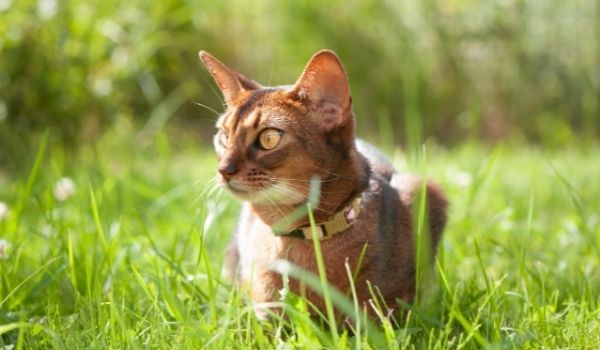
Breed Overview
Size (inches): 8 to 10 inches
Weight (pounds): 8 to 12 pounds
Coat Colors: Ruddy, Red, Blue, Fawn, Cinnamon
Personality: Sociable, friendly
Shedding: Low
Lifespan: 9 to 15 years
The Abyssinian cat breed has a slender, athletic look with a ticked tabby coat. Graceful and energetic yet docile cats, it is one of the ancient and most popular cat breeds in history. They are playful buddies who love having enough window perches in homes where they can hang out and play around. Abyssinians resemble small mountain lions by their looks. Since they are domestic cats, there are no restrictions upon keeping them as pets.
Abyssinian cats come in four standard colors: blue, fawn, ruddy, and sorrel. Their natural social disposition ability makes them behave well with other pets at home. Taking care of their smart brains by providing cat toys, exciting food puzzles, and hiding food around houses, keeps them mentally stimulated. Abys don’t like to be cuddled, picked up, or restrained.
Got two pets under one roof? Learn how to create the best-case scenario for your cat and dog living together.
3. Egyptian Mau
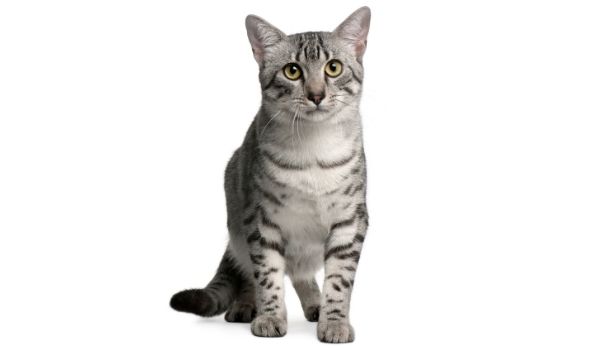
Breed Overview
Size (inches): 7 to 11 inches
Weight (pounds): 8 to 12 pounds
Hypoallergenic: Low
Coat Colors: Black/ebony, blue/gray, lavender/silver, chocolate/brown/sable
Personality: Sociable, affectionate
Lifespan: 9 to 13 years
Egyptian Mau is the only naturally-seen domestic cat breed that was domesticated 4,000 years ago. It is one of the long-living cat breeds, having an average lifespan of 15 to 20 years. They are graceful, energetic, and intelligent wild-like cats with distinctive yet impressive features – gooseberry green eyes being one of them. Egyptian Mau is an affectionate, expressive cat breed that cheerfully shares its love with the parent family.
Egyptian Maus are sometimes deemed as “aloof” because early socialization is crucial for them. They take time to form bonds with new pets or unfamiliar faces. Mau is an athletic and agile cat breed that can run up to 30 miles per hour. At home, they exhibit their hunting skills by chasing small insects. You may find them on top of bookshelves or refrigerators, as these are Mau’s favorite places.
Want to know more about Egyptian cats? Learn about 8 Egyptian cat breeds.
4. Nebelung
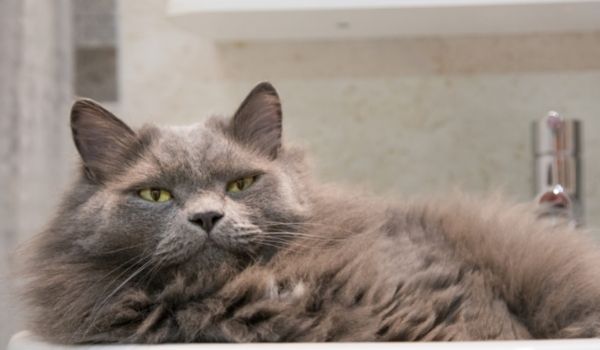
Breed Overview
Size (inches): 9 to 13 inches
Weight (pounds): 7 to 15 pounds
Hypoallergenic: No
Coat Colors: Blue / gray
Personality: Affectionate, shy
Lifespan: 11 to 18 years
Nebelung is a relatively new but rare breed of cat that resembles a lot with short-haired Russian Blue. These are moderate-sized breeds having soft and striking blue-grey coats. Sometimes, Nebelungs have silver-tipped coats around their heads and neck, which gives them a shimmery appearance.
To meet the physical and mental requirements of Nebelung’s playful side, ensure the presence of appropriate and interactive cat toys and other enrichment sources to keep them active, exercised, and entertained.
They develop good bonds with their owners and show strong attachment to one of the family members at home. They love to sit quietly near their favorite human friend or in their lap. Nebelungs are affectionate but may not warm up with strangers and exhibit a reserved attitude towards them. This is not an unusual case about this breed that they may hide away when visitors are at your place.
5. Bengal
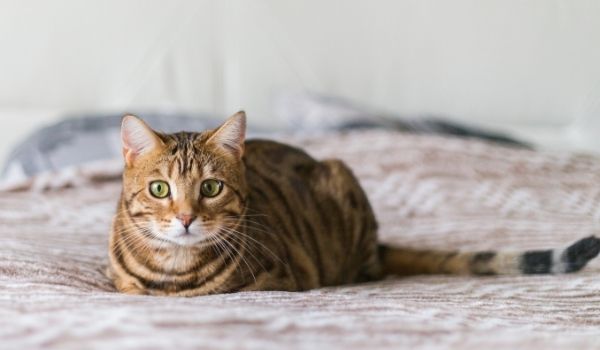
Breed Overview
Size (inches): 8 to 10 inches
Weight (pounds): 8 to 15 pounds
Hypoallergenic: No
Coat Colors: lavender / silver chocolate / brown / sable
Personality: Sociable affectionate bold
Lifespan: 9 to 15 years
The Bengal cat breed is an extremely active and intelligent cat breed with a wild appearance. Its coat looks as if it has been sprinkled with glitters because of iridescent sheen hairs. Bengals are amused by simple things such as dripping taps and flowing water. They enjoy climbing high places and are always on alert, which means nothing can escape their notice. If you have a Bengal cat and want to manage its energy, it is better to get it some tall scratch posts and window perches.
You may see Bengals constantly on the move unless it’s their nap time. This kitty is fully energetic when it has an active home or a feline partner. It is good to provide them with plenty of toys, interesting games, and environmental enrichment activities. If their feline partners or human friends are willing to play, they can spend hours playing. Bengal is a happy, curious, and playful cat.
Unlike other cats that are afraid of water, most Bengal cats are also fond of playing in the water. Always keep an eye on them if you have an aquarium at home.
Warm your heart by watching the video below of a few Bengal kittens, testing which one of them is the strongest.
6. Toyger
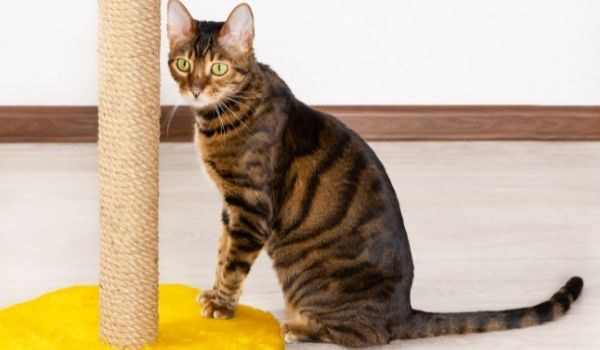
Breed Overview
Size: 9 to 16 inches
Weight: 7 to 15 pounds
Coat Colors: Orange, black, and white
Hypoallergenic: No
Personality: Friendly and outgoing
Lifespan: 10 to 15 years
Toyger has a wild tiger-like look, but it is a domesticated cat. It is a medium-sized cat breed having muscular bodies, round heads, and high shoulders. They have long toes and big paws but smaller legs in comparison to other breeds. Toyger has a distinctive striped appearance, the kind of stripes a tiger has. The adaptable nature of Toygers makes them good pets and easy-going feline partners.
Toyger is a vocal cat, and its talking mode is always on. It seems like it always has something to say. It is a friendly cat and can easily get along with other pets and children. These cats are easy to leash train, so you can also take them out.
7. Savannah Cat
Breed Overview
Size (inches): 14 to 17 inches
Weight (pounds): 12 to 25 pounds
Hypoallergenic: No
Coat Colors: Black/ebony, lavender/silver, chocolate/brown/sable
Eye Color: Ranges from light amber to dark brown
Personality: Affectionate, bold
Lifespan: 12 to 20 years
Savannah is an elegant cat with a graceful neck, long legs, and big pointy ears. They are great companions even for children and other pets. You can train these cats to walk on a leash. The curious nature of Savannah makes it capable of finding if there is any trouble around the corner as they notice everything around with speed.
To keep Savannah mentally stimulated, giving them interactive toys, puzzles, and areas for climbing is an excellent option. Savannah is a naughty, adventurous baby who will hide itself and then hit you when you are not attentive. They love to climb high places and may even knock things down because of their playful, mischievous nature. Similar to Bengals, Savannah is also fond of playing in the water.
8. Bobcat
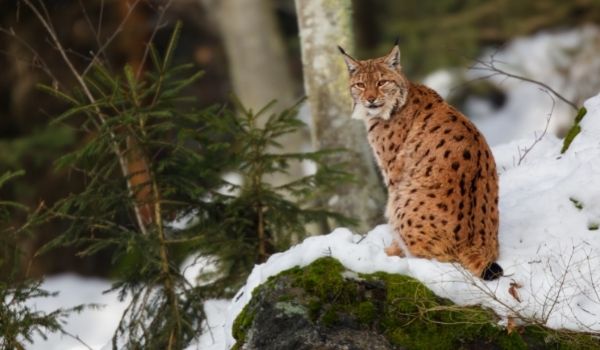
Breed Overview
Size (inches): 20 to 24 inches
Weight (pounds): 8 to 17 pounds
Hypoallergenic: No
Coat Colors: All shades of brown
Personality: Easy-going, friendly, affectionate, active, and intelligent
Lifespan: 13 to 15 years
Don’t they look exactly like tigers? It’s as if a kid tiger is sitting on the snow!
Bobcats, also known as red lynx, are native to North America. If you raise a bobcat from kittenhood, they become good pets as they may form a strong bond with owners. They can also develop a good bond with other pets such as other cats, dogs, and sometimes even deer (if they are raised together ).
That said, bobcats are not regular house cats. In the US, only five states (Alabama, Nevada, North Carolina, South Carolina, and Wisconsin) have no laws about keeping bobcats. While other states either completely ban exotic pets, such as bobcats, or allow them with specific permits, registration, or both. The latter category of states include Arizona, Delaware, Florida, Indiana, Maine, Mississippi, Missouri, North Dakota, Oklahoma, Pennsylvania, Rhode Island, South Dakota, Texas and Wisconsin.
The reason is that bobcats can be dangerous. Learn more here in our detailed article, “are Bobcats dangerous for humans and pets?”
If you want to keep a bobcat, check with your state and see which type of bobcat you can legally own.
9. Canadian Lynx
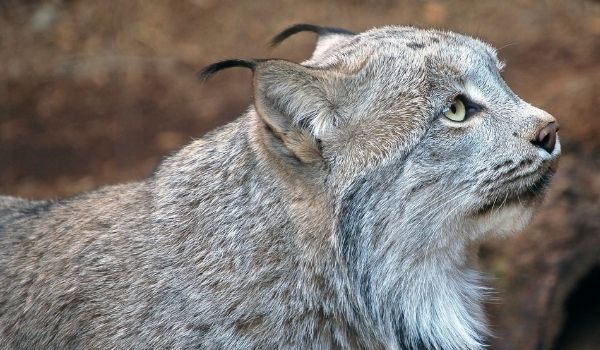
Breed Overview
Size (inches): 24 to 26 inches
Weight (pounds): 17 to 26 pounds
Lifespan: 10 to 20 years
Canadian Lynx is a solitary cat who values its own company rather than people. These cats are adept climbers and love to be at the highest places in a home, such as tall cat trees and posts.
Canadian Lynx doesn’t end up in a much-devoted relationship with their owners, like other cat breeds, but their temperament issues are rather less severe. They may behave well with strangers but are not much interested in going on walks. The enclosure for a Canadian larynx should be designed in such a way to accommodate its climbing instincts.
If you have made up your mind about keeping a Canadian Lynx, check with your state first. You can legally keep one only in Alabama, North Carolina, South Carolina, Wisconsin, and Nevada. Other states may require permits.
10. Siberian Lynx
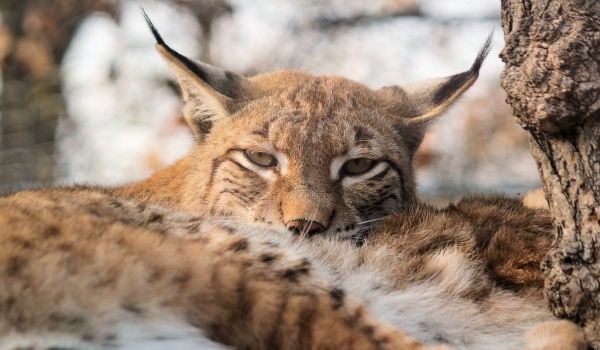
Breed Overview
Size (inches): 10 to 12 inches
Weight (pounds): 12 to 15 pounds
Hypoallergenic: Yes
Coat Colors: White black / ebony red / orange blue / gray lavender / silver cream / beige / tan
Personality: Sociable, Affectionate, bold
Lifespan: 8 to 10 years
Siberian Lynx is a very playful, energetic cat breed that loves walking on a leash. To keep Siberian cats at home, try to provide them with a spacious home where no breakable objects are present. Siberian Lynx are characterized as having dog-like personality traits. These are affectionate creatures who love to play by knocking over anything that comes their way. You may find them following you wherever you go, including bathrooms.
These cats love to watch you do whatever you do, whether it’s reading newspapers or books, preparing food, or doing work on your laptop. Sometimes they may even try to interrupt you by pressing the keys of your laptop.
The rule for keeping a Siberian Lynx is the same as for their Canadian counterparts.
11. Ocelots
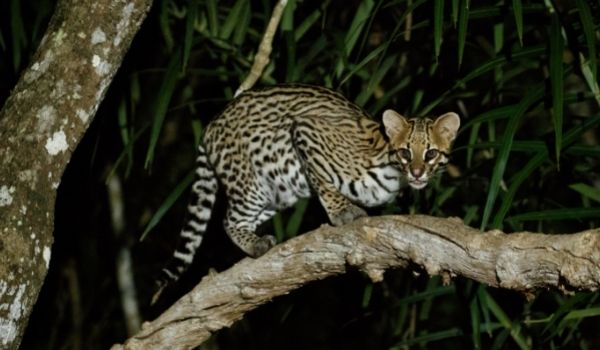
Breed Overview
Size (inches): 29 to 39 inches
Weight (pounds): 14.5 to 25 in females and 15 to 34 pounds in males
Lifespan: Upto 20 years
These are small wild cat breeds found in the United States, Central America, Mexico, Brazil, and other South American countries. Ocelot coats have distinctive markings that attract pet owners to keep them at home. The pattern of each Ocelot is unique, having dark spots on a white, tan, or orange coat. Ocelots are nocturnal animals which means they are more active at night time and sleep during the day.
This cat breed is challenging to keep as pets because they may not follow the disciplinary command and may have a pungent odor. Female Ocelots may produce a growl which could be a bit disturbing, and this trait doesn’t favor keeping them as pets.
But is it legal to keep an Ocelot? When it was an endangered species, it was illegal to keep one. Lately, however, the regulations have been relaxed. But it still varies from state to state. For instance, keeping them as pets is completely banned in New England and Alaska. In other states, you may be required to pay a certain fee to keep them as pets.
12. Geoffroy’s Cat
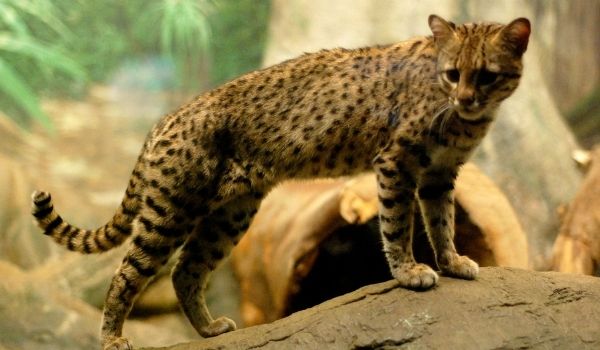
Breed Overview
Size (inches): 23 inches
Weight (pounds): 4 to 17 pounds
Lifespan: 14 years
The natural habitat of Geoffroy’s cat is southern and central-south America. This breed is one of the smallest wild cat species on earth. It only weighs between 4 to 8 pounds when fully grown. Just like Ocelots, Geoffroy’s cats are also nocturnal hunters, which means they are more active when you are asleep.
They don’t impose any threat to humans if kept as a pet. But it is not a preferable pet choice because they are timid and less social pets and may need a lot of privacy.
The laws regarding keeping Geoffroy’s cats as pets are the same as Ocelots.
13. Caracals

Breed Overview
Size (inches): 18 inches
Weight (pounds): Females are 13 to 35 pounds, males are 18 to 44 pounds
Lifespan: Up to 17 years
Caracals are medium-sized wild animals found in Southwest Asia and Africa. This cat breed is famous for its distinct facial markings, long legs, reddish-gold short hair coats, and large black tufted ears. The weight of an adult caracal ranges between 20 to 40 pounds.
To keep Caracals as pets is not appreciated, as they are wild and strong opportunistic hunters that may put the safety of children and other pets in your house at risk. Their wild nature and aggressive behavior become more visible when they become older. At this stage of their lives, the desire to hunt becomes prominent in them.
Legally speaking, laws vary from state to state. However, licensed individuals can keep one in Arizona, Arkansas, Delaware, Florida, Indiana, Maine, Mississippi, Missouri, Montana, North Dakota, Oklahoma, Pennsylvania, Texas, and South Dakota.
14. Fishing Cats
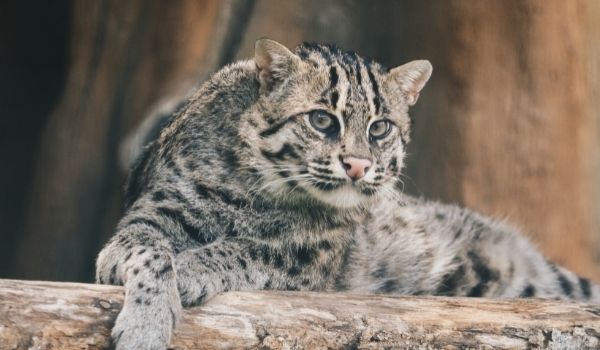
Breed Overview
Size (inches): 33-45 inches
Weight (pounds): 18-31 pounds
Lifespan: 12 years
Fishing cats are wild cats native to South and Southeast Asia. They weigh between 11 – 35 pounds. Fishing cats are wild cats with sharp teeth and claws; keeping them as pets is never a good idea. This breed of cats has stocky bodies with short tails and short legs.
As its name implies, it loves to play in the water. They are adept swimmers that can enter the water frequently to catch fish. Fishing cats are skilled hunters having powerful bodies. They are not afraid to get their paws wet due to water. They are capable of swimming long distances to catch their prey.
15. Jungle Cats
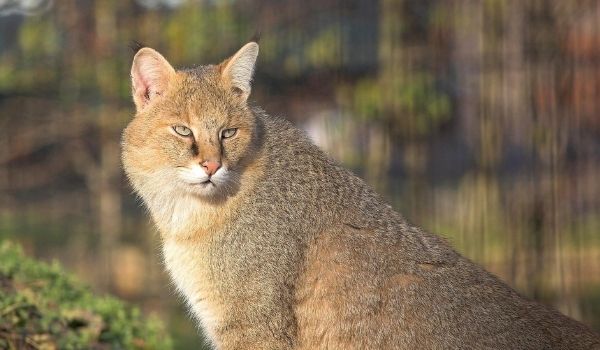
Breed Overview
Size (inches): 14 inches
Weight (pounds): 9 to 35
Lifespan: 15 to 20 years
Jungle cats, also called reed cats and swamp cats, are found most commonly in Southern China, South and Southeast Asia, and the Middle East. The Jungle Cat breed is a wild cat species that is frequently used to produce hybrids with domesticated cats. They resemble overgrown house cats. Its weight ranges from 11 to 20 lbs ( i.e., 5 to 9 kgs). Jungle cat’s coat color varies from sandy to greyish brown to yellowish-grey or tawny red.
They prefer quiet places and privacy. Like other cats on the list, these are wild cats and rarely make good pets, even if the law allows doing so.
16. Asian Leopard Cats
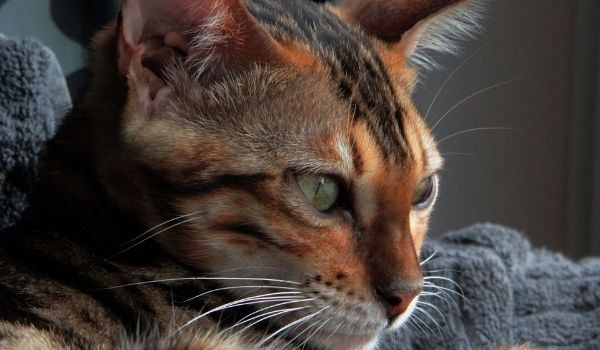
Breed Overview
Size (inches): Medium
Weight (pounds): 8 to 15 pounds
Lifespan: 10 to 13 years
Asian Leopard cats are found in South, Southeast, and East Asia. Its size is the same as that of a housecat (usually 10 – 15 lbs).=. The fur color of these cats varies from silver-grey to yellowish. This breed bears black markings that can be spotted based on its subspecies. Besides its ability to climb trees, it can also swim.
Asian Leopard cats are not ideal pets because it takes too long to train this breed. Also, it is more difficult to meet the needs of the Asian leopard cat than other domesticated cat breeds. Owning Asian Leopard as a pet would become a full-time job because of its behavioral issues.
Also, most of its subspecies are illegal to keep as pets.
17. Cornish Rex
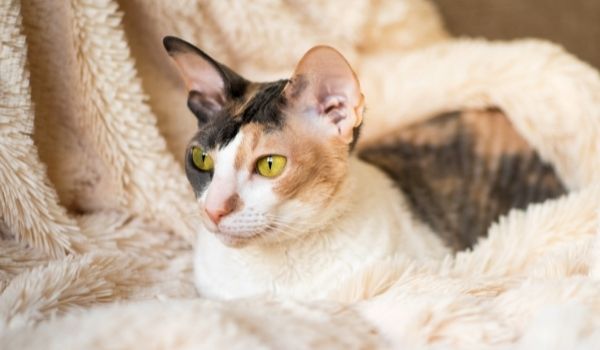
Breed Overview
Size (inches): 8 to 12 inches
Weight (pounds): 6 to 10 pounds
Coat Colors: White, black / ebony, red / orange, blue / gray, cream / beige / tan, chocolate, brown / sable
Personality: Sociable, bold
Lifespan: 11 to 15 years
This calico cat breed has a unique wavy coat that distinguishes it from other cats. Cornish Rex is an intelligent and highly active cat who loves to jump, play, and run. It is an excellent option commonly used for therapy purposes and is also a good traveler.
Cornish Rex is a good choice for people who wants a pet that maintains a good bonding with its owners. This cat loves to stay in close connection with its owners and needs the time of its owners every day. She loves to sit right next to you to grab the attention and time of their pet parents. They try to get involved in everything you are doing just to stay with you.
They are one of curly-haired cats and may require a little more grooming as compared to other cats.
18. Japanese Bobtail
Breed Overview
Size (inches): 8 to 9 inches
Weight (pounds): 6 to 10 pounds
Hypoallergenic: No
Coat Colors: White, black, chocolate, cream, red, lilac, and blue
Personality: Sociable, affectionate, bold
Lifespan: 9 to 15 years
This medium-sized cat can be found both in long and short-hair varieties. These cats have highly developed muscles that facilitate them to jump high. Japanese bobtails have a friendly, affectionate nature. It loves to interact with its owners and even with strangers. These smart, confident cats really like to bring objects by carrying them in their mouths. Taking a ride on one’s shoulder is one of their favorite hobbies.
These cats don’t prefer to stay alone; therefore, an active household where other pets are also present is the best place for such a cat. Japanese bobtails are capable of learning tricks and commands. They are smart enough to open the closed doors.
An interesting fact about Japanese Bobtails is that these cats don’t have tails.

